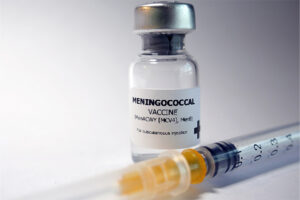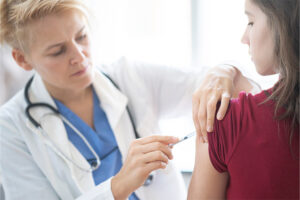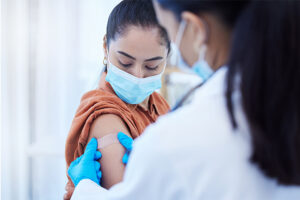Infectious Diseases
Adolescent Vaccinations
Adolescent Immunizations and Vaccine Hesitancy in the Current Era
Vaccination rates among adolescents are suboptimal, with vaccine hesitancy playing a pivotal role in limiting the uptake of certain vaccines, including those against COVID-19 and influenza. Overcoming vaccine hesitancy requires addressing parental and adolescent values, beliefs, and anxieties about vaccine safety.
Vaccine hesitancy refers to a state of mind regarding immunization that is marked by uncertainty, indecision, conflict, and/or opposition. It is best understood as a complex phenomenon with deep sociocultural and psychological roots. Vaccine hesitancy is nothing new. There were concerns in the 1980s about the diphtheria, tetanus, and pertussis vaccine, but it really took off in the late 1990s when the public came to fear that the measles, mumps, and rubella vaccine was causing autism. Of course, we know from many, many robust studies that it does not. More recently, we have seen an evolution of vaccine hesitancy associated with COVID-19 vaccines that we could not have anticipated or expected, and we are learning more about how complex the phenomenon of vaccine hesitancy truly is.
Here we are, more than 3 years after the start of the pandemic, and many people are still opposed to getting the COVID-19 vaccine. Why is that? I have been impressed by how deeply intertwined vaccine hesitancy is with people’s personal identities, their politics, and even their moral and cultural foundations. Hesitancy that emerged around the COVID-19 vaccines is itself contagious in that it seems to have generalized to all vaccinations.
To address vaccine hesitancy, it is important to manage expectations with different vaccines. People may think that getting an influenza or a COVID-19 vaccine means that they will not get the disease, but this is not necessarily the case. Rather, being vaccinated almost certainly means that you will not be hospitalized or die from being infected. So, people need to understand that the purpose of these vaccines is to prevent severe disease, not necessarily infection.
It is also important to help patients and their families put things into proper perspective. At the height of the COVID-19 pandemic, all antiviral treatments were under Emergency Use Authorization; we had very little experience with using them and did not know a lot about their potential side effects, especially in children. At the same time, hundreds of millions of people on the planet had been safely vaccinated with a COVID-19 vaccine. Despite this, many parents, fearful of the new vaccines, refused to have their children vaccinated, and instead chose to take their chances on the experimental antiviral therapies.
With the COVID-19 virus, we were dealing with something we really had not dealt with in about 100 years. We had little idea what was coming, and yet the vaccine was developed, and millions of lives were saved. However, we do need to accept that there is biology surrounding COVID-19 vaccination that we do not yet understand. For example, if you get 4 or 5 vaccine doses, are you better able to respond to the next variant, or are you somehow not as able to respond to the next variant? That question pertains to influenza vaccines as well. How does getting vaccinated for different strains of influenza each year set you up for the next year? To some extent, hesitancy can derive from a lack of knowledge, and there are still a lot of unknowns from a scientific point of view.
I am glad that we are focusing on adolescents because, during the pandemic, there was definitely a lot to learn about adolescents regarding concerns about the COVID-19 vaccine in this population and their susceptibility and vulnerability to the disease. Very early in the pandemic, we did not have a good sense of how affected children would be, but we did notice that adolescents were at risk for certain complications from COVID-19. Further, the awareness and concerns surrounding postinfectious complications such as inflammatory complications, multisystem inflammatory syndrome in children, myocarditis, thrombosis, and long-term effects actually made many people want to have their children vaccinated.
But then, when the vaccine became available, concerns about postvaccine myocarditis became an issue for some parents, even though it was much milder and less frequent than if it had resulted from COVID-19 itself. Many parents chose not to vaccinate their adolescent children because of this concern, which was founded on a lack of clear understanding regarding myocarditis in this population. In actuality, adolescents as an age group are at increased risk of myocarditis or pericarditis from any cause, not necessarily just from the COVID-19 virus. So, these risks definitely need to be put into perspective.
Another reason for vaccine hesitancy in general is related to what is known and what is perceived as potential risk, which is influenced by cultural and social norms and beliefs, as well as by the way that parents and adolescents interact. Children in this age group are old enough to have their own ideas and make their own decisions on many things, yet they often cannot make vaccination decisions on their own. With vaccines such as the human papillomavirus vaccine, parents may not understand the risks that their children face, and the adolescent may actually be more aware of the need for vaccination and less concerned about misinformation. The common goal should be to talk about these interactions and find an opportunity to address concerns and, in the end, improve public health.
The vaccines that are recommended for adolescents include the meningococcal vaccines, which are important because adolescents are at a greater risk of contracting meningococcal disease. We also recommend that patients in this age group receive boosters of the tetanus, diphtheria, and pertussis vaccine because, by adolescence, immunity wanes. Finally, there are continuing recommendations for influenza vaccination because there are outbreaks every year, and adolescents engage in various activities that increase their risk of contracting this virus, including just going to college. So, I would like to focus on the fact that we have interventions such as vaccines that can protect adolescents from preventable diseases and their complications and that we can monitor the safety of the vaccines.
With respect to vaccine hesitancy, one of the things that I have heard people say is, “Well, we don’t know the long-term consequences of vaccination.” It is important to put this concern into perspective. For example, if you take a medicine every day, such as a medication to treat cholesterol, hypertension, or diabetes, there is the potential that, over months or years, you could develop some sort of cumulative adverse effect that you did not recognize or appreciate at first.
The difference between these daily medications and vaccines is that you are given 1, 2, or maybe 3 vaccine doses in most instances. There is good documentation showing that if you do not see an adverse event within 6 to 8 weeks following vaccination, you are not going to see one. This statement applies to all vaccines, including those to prevent COVID-19. The known temporal relationship between vaccination and the onset of adverse events is actually the rationale that was used by the US Food and Drug Administration (FDA) when it waited 8 weeks after study participants received their initial COVID-19 vaccine before saying that the vaccine looks safe and extending dosing to different age groups.
We have no data showing that new side effects will develop from a vaccine after a long period of time. You may have a side effect that occurs shortly after vaccination that is long lasting, but that is different from having something that shows up months or even years down the road. It just does not happen with vaccines. That is something that we try to explain to our patients, but the potential for long-term consequences has become a very common misconception and point of argument for people who do not want to get a vaccine.
Many people are also concerned about the persistence of mRNA in their system after the receipt of an mRNA vaccine. In reality, when mRNA vaccines were first evaluated 15 to 20 years ago, they were given as “naked” mRNA. This approach was ineffective, as cellular RNases degraded the mRNA before it was able to get into cells. That is why it was necessary to use lipid nanoparticles to protect the mRNA and allow it to get into cells. Many people feel very passionately that, after the administration of an mRNA vaccine, the mRNA persists in our system. However, the fact is that the mRNA is degraded within a few days of vaccination, and the mRNA does not integrate into the genome.
As COVID-19 is the first time that mRNA vaccines have been used on a large scale, being afraid is understandable, as, on the whole, people are skeptical of things that are new or different. But we now have more experience with mRNA vaccines than with most any other vaccine, and the results have shown that mRNA vaccines are extremely effective and are one of the safest vaccine platforms in existence. In the end, mRNA vaccines result in the same product as our traditional vaccines: a protein against which our body makes an antibody to protect us from the infection.
Bedford H, Atwell K, Danchin M, Marshall H, Corben P, Leask J. Vaccine hesitancy, refusal and access barriers: the need for clarity in terminology. Vaccine. 2018;36(44):6556-6558. doi:10.1016/j.vaccine.2017.08.004
Centers for Disease Control and Prevention. Child and adolescent immunization schedule by age: recommendations for ages 18 years or younger, United States, 2024. CDC Website. Reviewed November 16, 2023. Accessed November 29, 2023. https://www.cdc.gov/vaccines/schedules/hcp/imz/child-adolescent.html
Sonawane K, Lin YY, Damgaciocglu H, et al. Trends in human papillomavirus vaccine safety concerns and adverse event reporting in the United States. JAMA Netw Open. 2021;4(9):e2124502. doi:10.1001/jamanetworkopen.2021.24502
Suran M. Why parents still hesitate to vaccinate their children against COVID-19. JAMA. 2022;327(1):23-25. doi:10.1001/jama.2021.21625













